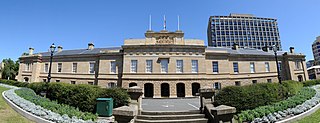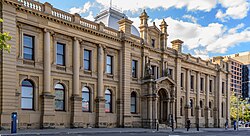
The Parliament of Tasmania is the bicameral legislature of the Australian state of Tasmania. It follows a Westminster-derived parliamentary system and consists of the King, the Tasmanian House of Assembly, and Tasmanian Legislative Council. Since 1841, both Houses have met in Parliament House, Hobart. The Parliament of Tasmania first met in 1856.

John Glover was an English-born artist. In later life he migrated to Van Diemen’s Land and became a pastoralist during the early colonial period. He has been dubbed "the father of Australian landscape painting."

Parliament House, Hobart, located on Salamanca Place in Hobart, Tasmania, Australia, is the meeting place of the Parliament of Tasmania. The building was originally designed as a customs house but changed use in 1841 when Tasmania achieved self-government. The building served both purposes from 1841 to 1904, when the customs offices were relocated.

The Tasmanian emu is an extinct subspecies of emu. It was found in Tasmania, where it had become isolated during the Late Pleistocene. As opposed to the other insular emu taxa, the King Island emu and the Kangaroo Island emu, the population on Tasmania was sizable, meaning that there were no marked effects of small population size as in the other two isolates.

Benjamin Duterrau was an English painter, etcher, engraver, sculptor and art lecturer who emigrated to Tasmania. There he became known for his images of Indigenous people and Australian history paintings.
Leonard Rodway was an English-born Australian dentist and botanist.

The Royal Society of Tasmania (RST) was formed in 1843. It was the first Royal Society outside the United Kingdom, and its mission is the advancement of knowledge.
The Queen Victoria Museum and Art Gallery (QVMAG) is a museum located in Launceston, Tasmania, Australia. The QVMAG is the largest museum in Australia not located in a capital city.

Maritime Museum Tasmania is a privately operated maritime museum dedicated to the history of Tasmania's association with the sea, ships, and ship-building, and is located at Carnegie House in Sullivans Cove, Hobart, Tasmania.

William Charles Piguenit was an Australian landscape painter.
Norman James Brian Plomley regarded by some as one of the most respected and scholarly of Australian historians and, until his death, in Launceston, the doyen of Tasmanian Aboriginal scholarship.

Henry Hunter (1832–1892) was a prominent architect and civil servant in Tasmania and Queensland, Australia. He is best known for his work on churches. During his life was also at various times a state magistrate of Tasmania, a member of the Tasmanian State Board of Education, the Hobart Board of Health, a Commissioner for the New Norfolk Insane Asylum and President of the Queensland Institute of Architects.
Alan Cameron Walker (1865–1931) was an Australian architect and philanthropist, born in Hobart, Tasmania. The grandson of John Walker, he was educated at Hutchins School and apprenticed to Henry Hunter. He produced many Tasmanian government and other buildings during his career, and was also a keen silversmith, serving as President of the Tasmanian Arts and Crafts Society for 25 years. He was the first President of the Tasmanian Architect's Registration Board.
The Tasmanian Heritage Register is the statutory heritage register of the Australian state of Tasmania. It is defined as a list of areas currently identified as having historic cultural heritage importance to Tasmania as a whole. The Register is kept by the Tasmanian Heritage Council within the meaning of the Tasmanian Historic Cultural Heritage Act 1995. It encompasses in addition the Heritage Register of the Tasmanian branch of the National Trust of Australia, which was merged into the Tasmanian Heritage Register. The enforcement of the heritage's requirements is managed by Heritage Tasmania.

Mary Morton Allport was an English Australian artist who is thought to be Australia's first professional female artist, lithographer, etcher and engraver. Allport painted landscapes and portrait miniatures.
Benjamin Law (1807-1882) was an English sculptor who worked in Australia.
Julie Gough is an artist, writer and curator based in Tasmania, Australia.
Violet Emma Vimpany was an Australian painter and etcher, and in later life also a master stonemason. She was an active member of, and regular exhibitor with, the Art Society of Tasmania. Her work is held in the permanent collection of the Tasmanian Museum and Art Gallery.

The Lady Franklin Gallery and Ancanthe Park is a historic sandstone museum and 2.96-hectare (7.3-acre) parkland in Lenah Valley, Tasmania, Australia. When it opened on 26 October 1843, it became the first privately funded museum in Australia.
Alexander Morton was an American-born Australian naturalist and museum curator.














